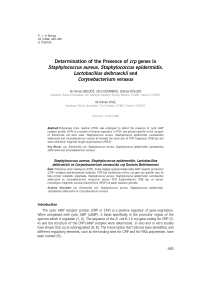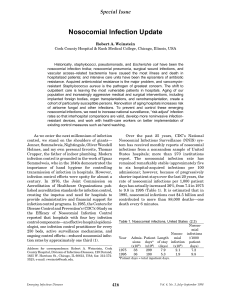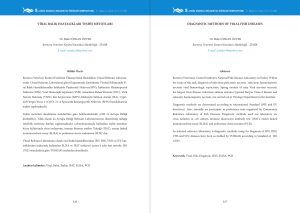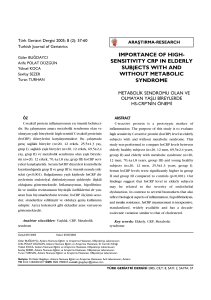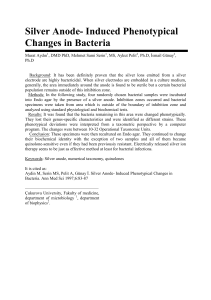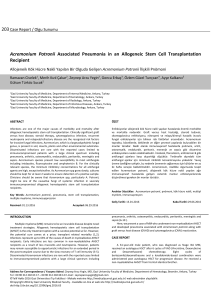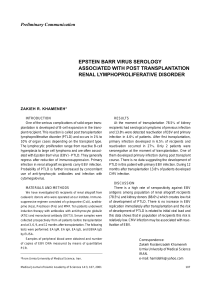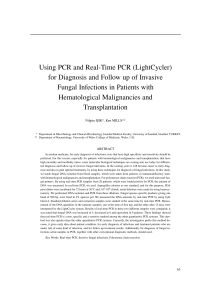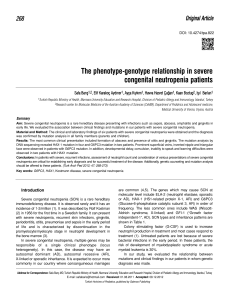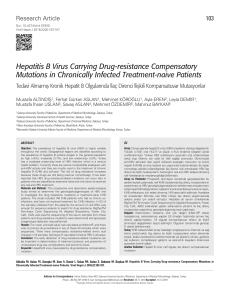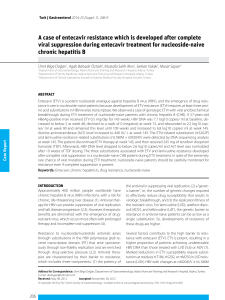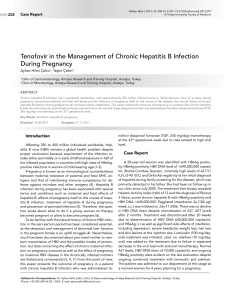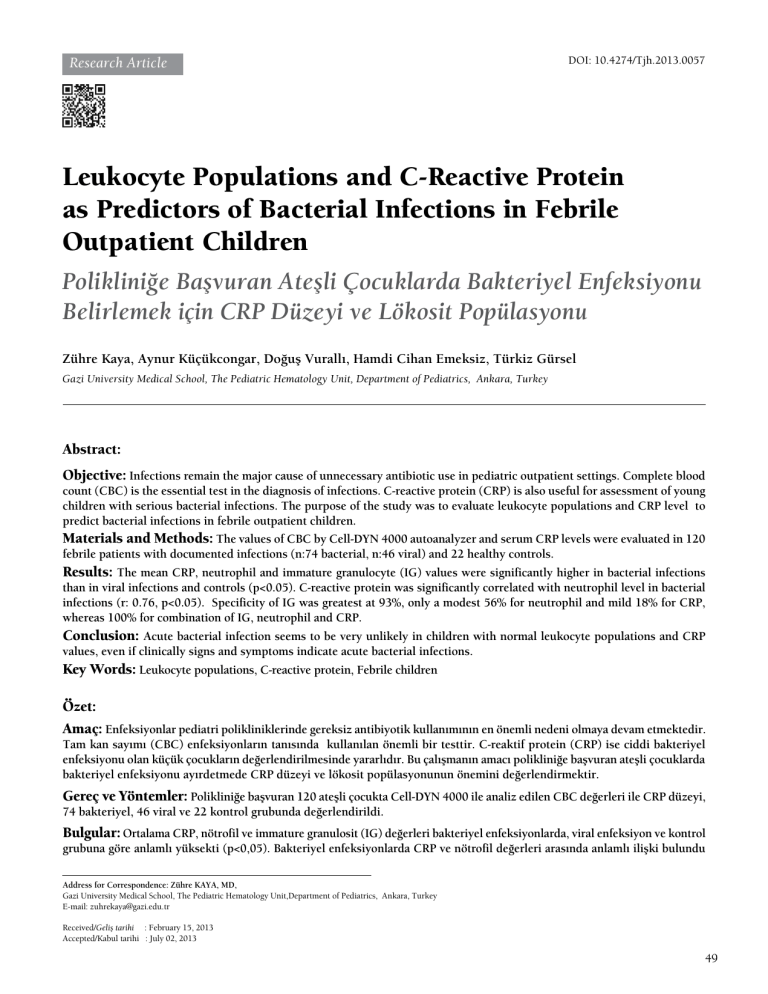
Research Article
DOI: 10.4274/Tjh.2013.0057
Leukocyte Populations and C-Reactive Protein
as Predictors of Bacterial Infections in Febrile
Outpatient Children
Polikliniğe Başvuran Ateşli Çocuklarda Bakteriyel Enfeksiyonu
Belirlemek için CRP Düzeyi ve Lökosit Popülasyonu
Zühre Kaya, Aynur Küçükcongar, Doğuş Vurallı, Hamdi Cihan Emeksiz, Türkiz Gürsel
Gazi University Medical School, The Pediatric Hematology Unit, Department of Pediatrics, Ankara, Turkey
Abstract:
Objective: Infections remain the major cause of unnecessary antibiotic use in pediatric outpatient settings. Complete blood
count (CBC) is the essential test in the diagnosis of infections. C-reactive protein (CRP) is also useful for assessment of young
children with serious bacterial infections. The purpose of the study was to evaluate leukocyte populations and CRP level to
predict bacterial infections in febrile outpatient children.
Materials and Methods: The values of CBC by Cell-DYN 4000 autoanalyzer and serum CRP levels were evaluated in 120
febrile patients with documented infections (n:74 bacterial, n:46 viral) and 22 healthy controls.
Results: The mean CRP, neutrophil and immature granulocyte (IG) values were significantly higher in bacterial infections
than in viral infections and controls (p<0.05). C-reactive protein was significantly correlated with neutrophil level in bacterial
infections (r: 0.76, p<0.05). Specificity of IG was greatest at 93%, only a modest 56% for neutrophil and mild 18% for CRP,
whereas 100% for combination of IG, neutrophil and CRP.
Conclusion: Acute bacterial infection seems to be very unlikely in children with normal leukocyte populations and CRP
values, even if clinically signs and symptoms indicate acute bacterial infections.
Key Words: Leukocyte populations, C-reactive protein, Febrile children
Özet:
Amaç: Enfeksiyonlar pediatri polikliniklerinde gereksiz antibiyotik kullanımının en önemli nedeni olmaya devam etmektedir.
Tam kan sayımı (CBC) enfeksiyonların tanısında kullanılan önemli bir testtir. C-reaktif protein (CRP) ise ciddi bakteriyel
enfeksiyonu olan küçük çocukların değerlendirilmesinde yararlıdır. Bu çalışmanın amacı polikliniğe başvuran ateşli çocuklarda
bakteriyel enfeksiyonu ayırdetmede CRP düzeyi ve lökosit popülasyonunun önemini değerlendirmektir.
Gereç ve Yöntemler: Polikliniğe başvuran 120 ateşli çocukta Cell-DYN 4000 ile analiz edilen CBC değerleri ile CRP düzeyi,
74 bakteriyel, 46 viral ve 22 kontrol grubunda değerlendirildi.
Bulgular: Ortalama CRP, nötrofil ve immature granulosit (IG) değerleri bakteriyel enfeksiyonlarda, viral enfeksiyon ve kontrol
grubuna göre anlamlı yüksekti (p<0,05). Bakteriyel enfeksiyonlarda CRP ve nötrofil değerleri arasında anlamlı ilişki bulundu
Address for Correspondence: Zühre KAYA, MD,
Gazi University Medical School, The Pediatric Hematology Unit,Department of Pediatrics, Ankara, Turkey
E-mail: [email protected]
Received/Geliş tarihi : February 15, 2013
Accepted/Kabul tarihi : July 02, 2013
49
Turk J Hematol 2014;31:49-55
Kaya Z, et al: Leukocyte Populations and C-Reactive Protein in Febrile Children
(r:0,76, p<0,05). Özgüllük IG için %93 ile en yüksek, nötrofil için %56 ile orta ve CRP için %18 düşük düzeyde bulunmasına
rağmen IG, nötrofil ve CRP kombinasyonu için %100 bulundu.
Sonuç: Çocuklarda klinik belirti ve bulgular akut bakteriyel enfeksiyonu işaret etse bile, normal lökosit popülasyonu ve CRP
değeri olan hastalarda akut bakteriyel enfeksiyon olasılığı düşüktür.
Anahtar Sözcükler: Lökosit popülasyonu, C-reaktif protein, Ateşli çocuk
Introduction
Despite rapid improvement in health care over the past
decades, fever continues to be a major cause of admissions,
laboratory work-up and antibiotic uses in pediatric outpatient
settings (POS) [1,2,3,4]. Fever due to viral infections can
be particularly difficult to distinguish from that in children
with clinical signs of bacterial infections [5].
To date, C-reactive protein (CRP) has been used to make
distinction between bacterial and viral infections but it has
been reported as neither sensitive nor specific enough for
bacterial infections [6,7]. One available strategy is to monitor
changes in leukocyte populations and CRP associated with
the host response to pathogens [8,9]. However, these markers
have mostly been studied in infants and younger children
below 3 years of age and for serious bacterial infections
excluding older children and localized bacterial infections
[10,11,12]. Furthermore, novel hemogram analysers allow
reliable measurement of a broad panel of complete blood
count (CBC) parameters. The variant lymphocyte (VL)
and immature granulocyte (IG) parameters have become
increasingly popular. Usefulness of monitoring VL and IG
for identifying infectious process have been examined in a
few studies [13,14,15,16]. However, its usefulness remains
controversial in children. The aim of this study was to
evaluate the usefulness of CRP and leukocyte populations
as early diagnostic markers of bacterial infections in febrile
outpatient children.
Material and Methods
Data were collected from 120 consecutive children who
presented with fever and 22 children with age matched
healthy controls during two months period at Pediatric
Outpatient Clinic of Gazi University Hospital. Patients
were eligible to participate if they had a clinical and/or
radiological and/or microbiological diagnosis of viral or
bacterial infections confirmed by residents in Department of
Pediatrics and decision for antibiotic treatment was made in
accordance with the management of infection guidance for
primary care at www.hpa.org.uk web page [17].
The inclusion criteria were: 1) age between 2 and 18
years, 2) fever was defined as an axillary temperature above
38o C, as used for the diagnostic criteria of febrile episodes
in the past 24 hours. We excluded infants <2 years, children
requiring hospitalization for fever, ongoing antibiotic
50
treatment at the time of evaluation and specific chronic
conditions.
Informed consent and approval by our Institutional
Review Board were obtained.
Laboratory Analysis
Venous blood samples for complete blood count (CBC)
were collected into vacutainer tubes containing K2EDTA
(Becton Dickinson, New Jersey, USA) and analysed by CellDYN 4000 Hematology Analyzer (Abbott Diagnostics, Santa
Clara, CA) within 6 hours of admission. The upper limit of
the reference interval for leukocyte populations was described
according to the age (Table 1) (18). Serum level of CRP was
measured using a nephelometric assay (Specific Protein
Analyser, Beckman, Marburg, Germany) with the normal range
as 0 to 6 mg/L. The abnormal values for CRP and leukocyte
populations were regarded as above the upper normal limit of
the reference interval. The microbiological tests including viral
serology for EBV, CMV, HSV, Parvo-B19, urine, throat and stool
cultures were retriewed from Hospital Information System. All
radiological tests were evaluated by expert radiologists.
Statistical Analysis
Statistical analysis was performed using SPSS 15.0 (SPSS
Inc., Chicago, IL). Data was expressed in mean±SD. All
the categorical variables were calculated using Chi-square
analysis. Different groups of patients were compared using
the Mann-Whitney U test and correlations were calculated
by Spearman’s correlation test. Wilcoxon test was used
to evaluate within the group comparison. Parameters
considered significantly associated with a high risk of
bacterial infections were selected in univariate analysis,
and the logistic regression for multivariate analysis was
calculated for odds ratio (OR) and 95% confidence interval
(CI). P values <0.05 were considered to be statistically
significant.
Results
Demographic and clinical characteristics of patients are
summarized in Table 1. Of the 120 children, 76 (63.4%) were
boys and 44 (36.6%) were girls. The median age was 5 years
(2-18 years). There was no difference between bacterial and
viral pathogens in respect to mean age and gender (p>0.05).
Infection Types and Locations
The most common primary sites of infection in order of
frequency were ear-nose-throat, lung and urinary tract system.
Turk J Hematol 2014;31:49-55
Kaya Z, et al: Leukocyte Populations and C-Reactive Protein in Febrile Children
Seven (5.8%) of the 120 children had definitive and 67 had
(56.0%) probable bacterial infections. Probable viral infections
comprised 44 patients (36.6%) with upper respiratory tract
infections along with flu-like symptoms and negative bacterial
markers (no viral cultures were performed), one patient with
documented EBV, and one with Parvo-B19 (1.6%).
CBC and CRP Levels
The mean levels of CRP and the leukocyte populations
are demonstrated in Table 2. At the time of diagnosis,
patients with bacterial infections had increased serum
CRP level, neutrophil, lymphocyte, and monocyte percent
compared with the control group (p<0.05).
The mean level of serum CRP, neutrophil and IG levels
showed significant decrease two weeks after the start
of antibiotic treatment as compared to their baseline at
diagnosis (p<0.05). Elevated CRP and neutrophil levels
were noted in only 27 of 67 patients with probable bacterial
infections who were treated with antibiotics.
Univariate analysis showed that a high levels of CRP and
neutrophils were associated with bacterial infections, while
VL positivitiy was more diagnostic for viral infections in
febrile children. In multivariate analysis, CRP was a better
indicator for bacterial infections with an odds ratio of 6.1
(95% CI, 1.5-24.6 ) (Table 3).
The specificity of neutrophil and IG levels was higher
for diagnosing bacterial infections than that of CRP alone.
However, the combination of CRP, neutrophil and IG levels
had the highest specificity for predicting bacterial infections.
Normal values for neutrophil, IG and CRP excluded bacterial
infections had a 100% specificity and positive predictive value
in a generic context. Variant lymphocyte and lymphocyte
levels were found highly specific and statistically superior to
CRP in viral infections (Table 4).
There was a significant positive correlation (r:0.76,
p<0.05) between CRP and neutrophil level in the bacterial
infections while there was a significant negative correlation
between CRP and lymphocyte (r:-0.75, p<0.05) for viral
infections (Figure 1).
otitis and sinusitis may indicate bacterial infections in many
cases of fever. Although cultures are the gold standard for the
diagnosis of bacterial infections, sampling and testing is time
consuming and their results are not immediately available.
Therefore, a predictive tool to diagnose bacterial infections
in fever is crucial for early diagnosis and treatment in POS.
Several inflammatory markers have been studied for the
diagnosis of infections. Among them, CRP is frequently used
and is a good marker for infection [22,23,24,25]. Few data
are available evaluating CRP for the detection of bacterial
infections in children with fever [25,26,27]. The prevalance
rate of bacterial infections varies between 28% and 82% in
febrile children seen at the emergency departments. In the
present study, we have found the prevalance of proven and
probable bacterial infections to be 62% in children with
fever who started antibiotic treatment in POS. So far, the
association between CRP and bacterial infections was only
evaluated in the hospitalized children or at the emergency
department and predominantly in younger children below
three years of age [6,7,8,9,10,11,12,25,26,27,28].
Most authors concluded that CRP >40 mg/dL indicates
severe bacterial infections [6,9,22]. We also found that the
bacterial infections had higher mean CRP levels compared
with the viral infections in POS. However, a multivariate
model showed that CRP was the only independent variable
for the association between viral and bacterial infections.
More recently, several authors have reported the quantitative
evaluation of CRP as a diagnostic marker of bacterial
infections, sensitivity and specificity ranging from 57% to
100% and from 50% to 100%, respectively [6,7,8,9,25]. In
our study, CRP was found to be a highly (89%) sensitivite
but has quite low (18%) specificity.
It has been widely accepted that CRP was not elevated
during viral infections. We found that CRP was weakly
positive in only 3 of 16 patients with viral infections. It
is possible that there may be coexisting latent bacterial
infections in these patients. Thus, CRP positivity alone
20.00
Discussion
Despite viral infections represent the most frequent
outpatient infections in children, the increasing rates of
antibiotic resistance due to unnecessary antibiotic use have
become a major threat for child health [1,2,3,4]. Therefore
an immediate and appropriate strategy for this population in
POS is required to prevent unnecessary antibiotic use and
to reduce treatment delays. In this study, we analysed 120
febrile patients in POS and validated the diagnostic value of
CRP and CBC for infectious complications in children.
The early diagnosis of bacterial infections in patients with
fever is challenging [19,20,21]. Focus of infection is uncertain,
and only a few clinical signs such as tonsillopharyngitis,
0.00
-20.00
-40.00
-250.00
-200.00
-150.00
-100.00
-50.00
0.00
Figure 1. Correlation between changes in C reactive protein
and neutrophil percent
51
Turk J Hematol 2014;31:49-55
Kaya Z, et al: Leukocyte Populations and C-Reactive Protein in Febrile Children
Table 1. Demographic features and clinical characteristics of patients.
n (%)
Age
2-7y
8-18y
Gender (Female/Male)
Clinical Diagnosis
Definitive bacterial
Strep. tonsillitis
Urinary tract infection
Probable bacterial
Otitis
Sinusitis
Tonsillitis
Lymphadenitis
Bacterial pneumonia
Urinary tract infection
Definitive virus
EBV
Parvo B19
Probable virus
Upper respiratory tract infections
Viral pneumonia
White Blood count (x109/L) (Age, Normal range)
1-3 yr (5.5-17.5)
Low
4-7 yr (5.0-17.0)
Normal
8-13 yr (4.5-13.5)
High
>13 yr (4.5-11.5)
Neutrophil percent (%) (Age, Normal range)
1-3 yr (22-46)
Low
4-7 yr (30-60)
Normal
8-13 yr (35-65)
High
>13 yr (50-70)
Lymphocyte percent (%) (Age, Normal range)
1-3 yr (37-73)
Low
4-7 yr (29-65)
Normal
8-13 yr (23-53)
High
>13 yr (18-42)
Monocyte percent (%) (Age, Normal range)
1-18 yr (2-11)
Normal
High
Variant lymphocyte (%) (n:89)
Absent
Present
Immature granulocyte (%) (n:89)
Absent
Present
C-reactive protein (mg/L) (n:62)
≤6
>6
52
87 (72.5)
33 (27.5)
44/76
2 (1.6)
5 (4.2)
6 (5.0)
11 (9.2)
33 (27.6)
6 (5.0)
4 (3.4)
7 (5.8)
1 (0.8)
1 (0.8)
38 (31.6)
6 (5.0)
11 (9.2)
95 (79.2)
14 (11.6)
12 (10.0)
68 (56.6)
40 (33.4)
37 (30.8)
77 (64.2)
6 (5.0)
79 (65.8)
41 (34.2)
67 (75.3)
22 (24.7)
75 (84.3)
14 (15.7)
32 (51.8)
30 (48.2)
Turk J Hematol 2014;31:49-55
Kaya Z, et al: Leukocyte Populations and C-Reactive Protein in Febrile Children
Table 2. Changes in variables from baseline to two weeks following antibiotic treatment.
Control
Baseline values
At 2 week values Changes in values
(mean±SD) n:22 (mean±SD) (n:55) (mean±SD) (n:55) (mean±SD) (n:55)
WBC(x109/L)
9.6±2.1
10.1±5.2
8.6±3.5
-1.4±6.2
Neutrophil (%)
43.1±12.3¶
51.3±19.1*
42.1±13.3*
-9.2±18.8
Lymphocyte (%)
45.3±12.1¶
31.3±17.9*
45.7±13.6*
9.4±19.1
Monocyte (%)
6.9±2.1
9.1±3.1*
7.8±2.4*
-1.1±2.9
Variant
lymphocyte (%)
-
1.4±4.6*
0.42±1.7*
-1.9±7.1
Immature
Granulocyte (%)
-
0.37±1.1*
0.14±0.64*
-0.25±1.1
CRP(mg/L)
2.1±5.8¶
49.9±56.8*
8.3±11.8*
-63.4±76.5
¶
Data are expressed at mean±standard deviation
*p<0.05, Between baseline and at 2 weeks
¶
p<0.05, Between baseline and control
Table 3. C-reactive protein and leukocyte populations in relation to the infections using by univarite and multivariate
analysis.
C-reactive protein (n:62)
Normal
Abnormal
Leukocyte (n:120)
Normal
Abnormal
Neutrophil (n:120)
Normal
Abnormal
Lymphocyte (n:120)
Normal
Abnormal
Monocyte (n:120)
Normal
Abnormal
Variant lymphocyte (n:89)
Absent
Present
Immature granulocyte (n:89)
Absent
Present
Viral
infection
n (%)
Bacterial
infection
n (%)
Univariate Multivariate OR (95%CI)
p value
p value
13 (81.3%)
3 (18.8%)
19 (41.3%)
27 (58.7%)
0.006*
43 (93.5%)
3 (6.5%)
37 (80.4%)
9 (19.6%)
63 (85.1%)
11 (14.9%)
43 (58.1%)
31 (41.9%)
0.24
44 (95.7%)
2 (4.3%)
70 (94.6%)
4 (5.4 %)
0.96
29 (63.0%)
17 (37.0%)
50 (67.6%)
24 (32.4%)
0.75
23 (62.2%)
14 (37.8%)
44 (84.6%)
8 (15.4%)
0.03*
33 (91.7%)
3 (8.3%)
42 (79.2%)
11 (20.8%)
0.14
0.02*
0.02*
6.1(1.5-24.6)
2.1(1.1-3.8)
1.7 (1.0-3.1)
*p<0.05
may not be helpful to estimate the causative pathogens
particularly in febrile patients. Other authors have
described “unconventional” inflammatory markers such
as procalcitonin, interleukin 6, which have been used as
research tools but not achieved widespread acceptance in
routine practice [22,23,24].
Some laboratory routine tests such as CBC are fast,
economical, and universally available, and often aid
53
Turk J Hematol 2014;31:49-55
Kaya Z, et al: Leukocyte Populations and C-Reactive Protein in Febrile Children
Table 4. Diagnostic accuracy of C-reactive protein (CRP) and leukocyte populations in viral and bacterial infections.
Sensitivity
Specificity
Positive predictive
value
Negative predictive
value
52%
19%
56%
94%
77%
90%
29%
28%
C-reactive protein(CRP)
Neutrophil+IG
Neutrophil+CRP
IG+CRP
Neutrophil+CRP+IG
Viral infections
Lymphocyte
90%
13%
52%
20%
13%
18%
100%
69%
93%
100%
76%
100%
83%
90%
100%
38%
29%
34%
29%
29%
5%
95%
66%
62%
Variant lymphocyte
(<5%)
16%
96%
75%
61%
Bacterial infections
Neutrophil
Immature granulocyte(IG)
primary clinicians with decision making about patients
with suspected bacterial infections [29,30]. Thus the rapid
availability of the results of CBC as well as CRP could provide
considerable advantage for both patients and clinicans.
In the present study, we have used Cell-DYN 4000 device
which enabled us simultaneously measure several different
CBC parameters. As in other studies, our results showed a
significant positive correlation between CRP and neutrophil
levels in supporting of bacterial infection. On the other
hand, in patients with viral infections, lymphocyte showed
negative correlation with CRP level (r:-0.75, p<0.05) [24].
The suggested cut-off values of <5% variant lymphocyte
excluded viral infections with the 96% specificity (Table 4).
Our results have shown that normal neutrophil and IG
levels and CRP value excluded bacterial infections with a
predictive value of 100% in children presenting with fever.
Antibiotics should not be recommended in such cases with
a normal neutrophil and IG levels and CRP value, even
when bacterial infections is suspected clinically. If typical
signs and symptoms of acute bacterial infections continue
and abnormal leukocyte populations and/or CRP value
increases above the upper limit of the reference interval,
the patient should be treated by antibiotic. Otherwise,
continued observation is recommended. A single CRP
test will not be very indicative of bacterial infection but a
combination of neutrophil, IG and CRP may provide more
valid information considering the complex relationship
between the antibiotic use and the clinical features of
bacterial infection. To our knowledge, there are no
previous studies relating measurement of IG and VL in
febrile outpatient children. Although our results should be
confirmed in a prospective study including larger number
of patients, we believe that IG, neutrophil and CRP values
54
may guide physicians to make a distinction between viral
and bacterial infections.
In conclusion, neutrophil and IG levels together with CRP
constitute a rapid and cheap diagnostic tool with moderate
diagnostic value in children with bacterial infections. Using
these laboratory test, physicians can avoid unnecessary
antibiotic use in approximately two thirds of children with
suspected bacterial infections in POS.
Conflict of Interest Statement
The authors of this paper have no conflicts of interest,
including specific financial interests, relationships, and/or
affiliations relevant to the subject matter or materials included.
References
1. Dosh SA, Hickner JM, Mainous AG, Ebell MH. Predictors
of antibiotic prescribing for nonspecific upper respiratory
infections, acute bronchitis, and acute sinusitis. An UPRNet
Study. J Fam Pract 2000;49:407-414.
2. Mangione-Smith R, Elliott MN, Stivers T, McDonald L,
Heritage J, McGlynn EA. Racial/Ethnic variation in parent
expectations for antibiotics: implications for Public Health
Campaigns. Pediatrics 2004;113:385-394.
3. Mangione-Smith R, Elliott MN, Stivers T, McDonald LL, Heritage
J. Ruling out the need for antibiotics: are we sending the right
message? Arch Pediatr Adolesc Med 2006;160:945-952.
4. Linder JA, Schnipper JL, Tsurikova R, Volk LA, Middleton
B. Self reported familiarity with acute respiratory infection
quidelines and antibiotic prescribing in primary care. Int J
Qual Health Care 2010;22:469-475.
5. Lorrot M, Moulin F, Coste J, Ravilly S, Guerin S, Lebon
P, Lacombe C, Raymond J, Bohuon C, Gendrel D.
Procalcitonin in pediatric emergencies: comparison with
Kaya Z, et al: Leukocyte Populations and C-Reactive Protein in Febrile Children
C-reactive protein, interleukin 6 and interferon alpha in the
differentation between bacterial and viral infections. Presse
Med 2000;29:128-134.
6. Putto A, Ruuskanen O, Meurman O, Ekblad H, Korvenranta
H, Mertsola J, Peltola H, Sarkkinen H, Vijanen MK, Halonen
P. C-reactive protein in the evaluation of febrile illness. Arch
Dis Child 1986;61:24-29.
7. Isaacman DJ, Burke BL. Utility of the serum C-reactive
protein for detection of occult bacterial infection in children.
Arch Pediatr Adolesc Med 2002;156:905-909.
8. Al-Gwaiz LA, Babay HH. The diagnostic value of absolute
neutrophil count, band count and morphologic changes
of neutrophils in predicting bacterial infections. Med Princ
Pract 2007;16:344-347.
9. Peltola V, Toikka P, Irjala K, Mertsola J, Ruuskanen O.
Discrepancy between total white blood cell counts and
serum C-reactive protein levels in febrile children. Scand J
Infect Dis 2007;39:560-565.
10.Isaacman DJ, Shults J, Gross TK, Davis PH, Harper M.
Predictors of bacteriemia in febrile children 3 to 36 months
of age. Pediatrics 2000;106:977-982.
11.Pulliam PN, Attia MW, Cronan KM. C-reactive protein
in febrile children 1 to 36 months of age with clinically
undetectable serious bacterial infection. Pediatrics
2001;108:1275-1279.
12.Pratt A, Attia MW. Duration of fever and markers of serious
bacterial infection in young febrile children. Pediatr Int
2007;49:31-35.
13.Chan YK, Tsai MH, Huang DC, Zheng ZH, Hung KD.
Leukocyte nucleus segmentation and nucleus lobe counting.
BMC Bioinformatics 2010;11.558.
14.Roehrl MH, Lantz D, Sylvester C, Wang JY. Age dependent
reference ranges for automated assessment of immature
granulocytes and clinical significance in an outpatient
setting. Arch Pathol Lab Med 2011;135:471-477.
15.Senthilnayagam B, Kumar T, Sukumaran J, MJ, Rao KR.
Automated measurement of immature granulocytes:
performance characteristics and utility in routine clinical
practice. Patholog Res Int. 2012; DOI:10.1155/2012/483670.
16.Chaves F, Tierno B, Xu D. Quantitative determination of
neutrophil VCS parameters by the Coulter automated
hematology analyzer: new and reliable indicators for
acute bacterial infection. Am J Clin Pathol 2005;124:440444.
17.HPA. Management of infection guidance for primary care
for consultation and local adaptation.http://www.hpa.org.
uk/webc/HPAwebFile/HPAweb_C/1279888711402 (5 July
2010, date last accessed).
Turk J Hematol 2014;31:49-55
19.Baraff LJ. Management of fever without source in infants and
children. Ann Emerg Med. 2000;36.602-614.
20.Friedman JF, Lee GM, Kleinman KP, Finkelstein JA. Acute
care and antibiotic seeking for upper respiratory tract
infections for children in day care. Parental knowledge
and day care center policies. Arch Pediatr Adolesc Med
2003;157:369-374.
21.Brent AJ, Lakhanpaul M, Thompson M, Collier J, Ray S,
Ninis N, Levin M, MacFaul R. Risk score to stratify children
with suspected serious bacterial infection: observational
cohort study. Arch Dis Child 2011;96:361-367.
22.Hatherill M, Tibby SM, Sykes K, Turner C, Murdoch
IA. Diagnostic markers of infection: Comparison of
procalcitonin with C reactive protein and leucocyte count.
Arch Dis Child 1999;81:417-421.
23.Andreola B, Bressan S, Callegaro S, Liverani A, Plebani M, Da
Dalt L. Procalcitonin and C-reactive protein as diagnostic
markers of severe bacterial infections in febrile infants and
children in the emergency department. Pediatr Infect Dis J
2007;26:672-677.
24.Pourakbari B, Mamishi S, Zafari J, Khairkhah H, Ashtiani
MH, Abedini M, Afsharpairman S, Rad SS. Evaluation of
procalcitonin and neopterin level in serum of patients with
acute bacterial infection. Braz J Infect Dis 2010;14:252-255.
25.Sanders S, Barnett A, Correa-Velez I, Coulthard M, Doust J.
Systematic review of the diagnostic accuracy of C reactive
protein to detect bacterial infection in nonhospitalized
infants and children with fever. J Pediatr 2008;153:570574.
26.McCarthy PL, Jekel JF, Dolan TF Jr. Comparison of acute
phase reactants in pediatric patients with fever. Pediatrics
1978;62:716-720.
27.Tejani NR, Chonmaitree T, Rassin DK, Howie VM, Owen
MJ, Goldman AS. Use of C-reactive protein in differentiation
between acute bacterial and viral otitis media. Pediatrics
1995;95:664-669.
28.dos Anjos BL, Grotto HZ. Evaluation of C-reactive protein
and serum amyloid A in the detection of inflammatory
and infectious disease in children. Clin Chem Lab Med
2010;48:493-499.
29.Nixon DF, Parsons AJ, Elgin RP. Routine full blood counts
as indicators of acute viral infections. J Clin Pathol
1987;40:673-675.
30.Van den Bruel A, Thompson MJ, Haj-Hassan T, Stevens
R, Moll H, Lakhanpaul M, Mant D. Diagnostic value of
laboratory tests in identifying serious infections in febrile
children: systematic review. BMJ. 2011; 342:3082.
18.Dallman PR. Blood and blood-forming tissues, In Rudolph
AM, editor. Pediatrics. 16th ed. New York, AppletonCentury-Crofts, 1977. p. 1178.
55

